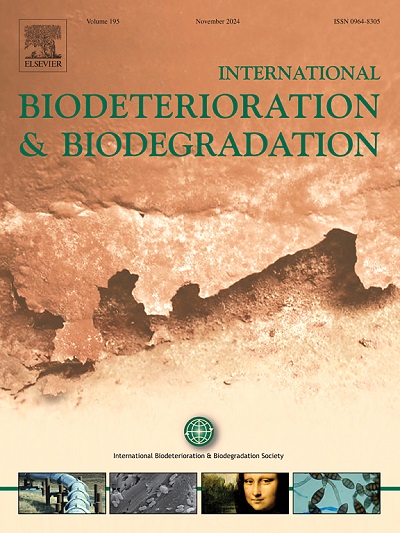Bioactivity and antibiofilm activity of metal and non-metal nanoparticles in DES against resistant microorganisms
IF 4.1
2区 环境科学与生态学
Q2 BIOTECHNOLOGY & APPLIED MICROBIOLOGY
International Biodeterioration & Biodegradation
Pub Date : 2025-05-27
DOI:10.1016/j.ibiod.2025.106121
引用次数: 0
Abstract
The increasing resistance of microorganisms to antibiotics necessitates the search for new therapeutic strategies, including the use of nanoparticles with bioactive properties. The aim of this study was to investigate the antibiofilm and antimicrobial properties of metal and non-metal (Ag, Cu, Se) nanoparticles, obtained in deep eutectic solvent (DES), against resistant bacterial strains. The study investigated the determination of the minimum inhibitory concentration (MIC) and minimum biocidal concentration (MBC) of selected Me-DES systems. The results showed that the MBCs of S. aureus ATCC 700699 and E. coli ATCC BAA -2523 for Ag-DES were 18.2 and 15.6 μg/mL, respectively, while those for Cu-DES and Se-DES were 125 μg/mL. Serial passages of bacterial cells were performed to assess the ability of microorganisms to develop resistance to the test systems, indicating their limited adaptability against Ag-DES and Cu-DES (MIC maintenance for 24 passages). The antibiofilm activity of the nanoparticles was confirmed by their ability to remove 12–37 % of S.Aureus bacterial biofilm and 23–51 % of E.coli biofilm after 24 h of exposure. In addition, the MTT cytotoxicity test showed that Me-DES systems exhibited low cytotoxicity against cell lines (A549). Analysis of the mobility of microorganisms after exposure to nanoparticles indicated a reduction in mobility capacity in the range of 14–68 % already at a concentration of 31.3 μg/mL, depending on the nanoparticles used. The study demonstrates that metal and non-metal nanoparticles in DES represent a promising system to combat resistant microorganisms, while reducing their ability to develop resistance and destroying the bacterial biofilm.
DES中金属和非金属纳米颗粒对耐药微生物的生物活性和抗生物膜活性
微生物对抗生素的耐药性日益增加,需要寻找新的治疗策略,包括使用具有生物活性的纳米颗粒。本研究的目的是研究在深度共熔溶剂(DES)中获得的金属和非金属(Ag, Cu, Se)纳米颗粒对耐药菌株的抗菌膜和抗菌性能。研究了所选Me-DES体系的最小抑菌浓度(MIC)和最小杀菌浓度(MBC)的测定。结果表明,金黄色葡萄球菌ATCC 700699和大肠杆菌ATCC BAA -2523对Ag-DES的MBCs分别为18.2和15.6 μg/mL, Cu-DES和Se-DES的MBCs分别为125 μg/mL。对细菌细胞进行连续传代,以评估微生物对测试系统产生耐药性的能力,表明它们对Ag-DES和Cu-DES的适应性有限(MIC维持24传代)。暴露24小时后,纳米颗粒对金黄色葡萄球菌生物膜的去除率为12 - 37%,对大肠杆菌生物膜的去除率为23 - 51%,证实了纳米颗粒的抗菌活性。此外,MTT细胞毒性试验表明,Me-DES系统对细胞株(A549)具有较低的细胞毒性。对暴露于纳米颗粒后微生物迁移率的分析表明,在浓度为31.3 μg/mL时,微生物的迁移能力已经降低了14 - 68%,这取决于所使用的纳米颗粒。该研究表明,金属和非金属纳米颗粒在DES中代表了一种很有前途的系统,可以对抗耐药微生物,同时降低它们产生耐药性的能力并破坏细菌生物膜。
本文章由计算机程序翻译,如有差异,请以英文原文为准。
求助全文
约1分钟内获得全文
求助全文
来源期刊
CiteScore
9.60
自引率
10.40%
发文量
107
审稿时长
21 days
期刊介绍:
International Biodeterioration and Biodegradation publishes original research papers and reviews on the biological causes of deterioration or degradation.

 求助内容:
求助内容: 应助结果提醒方式:
应助结果提醒方式:


